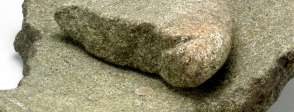The first activity uses images in For the classroom to investigate what the quern was for and how it was used.
Ask students to give their ideas of what the object might be. Encourage them to think about the quern and rubbing stone being used together. Show the model of the Egyptian man using a quern and get students to mime his movement. Then show them the photo of the quern from the National Museums and Galleries of Wales in For the classroom and help them work out that the white substance is flour.
Bring in some pestles and mortars and some wheat, barley or oat grains from a health food shop. Students can have a go grinding the grains and see how much flour they can make. Discuss whether it was hard to grind the grain and what kinds of flatbread they may already be familiar with. Use a simple flatbread recipe to make bread. Compare with risen breads.
Look at the six objects in A bigger picture. Discuss what they were for. Students could use them to create a storyboard of the process of making bread from clearing the land to baking.
These two activities look at the growth of farming. They use quite complex resources, but ones which students will be able to understand with a little help.
Use the interactive map in For the classroom to investigate the spread of farming from the Middle East. What is the earliest date the students can find with evidence of farming in Britain? Compare with other dates they can find form Europe and the Middle East. Discuss the reasons why the practice of farming may have spread and how it was spread.
Explore the timeline from University College London. Start by choosing one part of the world and working out what was happening when. Then compare different parts of the world. Students could transfer the information from the timeline to a map of the world
Look at the decoration on the pots in A bigger picture. Discuss how the decorations were made. Students can try out different ways of making marks in clay using points, sticks, cords, pebbles, fingernails and other tools. In this period pottery was not made on a wheel, but shaped by hand. Students could make some Neolithic vessels and decorate them using the techniques they like best.
Discuss why people would bother to decorate functional vessels. Look at the jadeite axe and the axes from Northern Ireland in For the classroom. Why would anyone make an axe that was never used to cut trees or a lot of axes that were too big to use?
Hunter-gatherer or farmer? Using the objects and activities in this Object File and those in Object File: Mesolithic headdress, ask students to list the advantages and disadvantages of the two lifestyles. Which lifestyle would they prefer?


